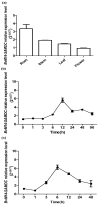Overexpression of a S-Adenosylmethionine Decarboxylase from Sugar Beet M14 Increased Araidopsis Salt Tolerance
- PMID: 31018555
- PMCID: PMC6515516
- DOI: 10.3390/ijms20081990
Overexpression of a S-Adenosylmethionine Decarboxylase from Sugar Beet M14 Increased Araidopsis Salt Tolerance
Abstract
Polyamines play an important role in plant growth and development, and response to abiotic stresses. Previously, differentially expressed proteins in sugar beet M14 (BvM14) under salt stress were identified by iTRAQ-based quantitative proteomics. One of the proteins was an S-adenosylmethionine decarboxylase (SAMDC), a key rate-limiting enzyme involved in the biosynthesis of polyamines. In this study, the BvM14-SAMDC gene was cloned from the sugar beet M14. The full-length BvM14-SAMDC was 1960 bp, and its ORF contained 1119 bp encoding the SAMDC of 372 amino acids. In addition, we expressed the coding sequence of BvM14-SAMDC in Escherichia coli and purified the ~40 kD BvM14-SAMDC with high enzymatic activity. Quantitative real-time PCR analysis revealed that the BvM14-SAMDC was up-regulated in the BvM14 roots and leaves under salt stress. To investigate the functions of the BvM14-SAMDC, it was constitutively expressed in Arabidopsis thaliana. The transgenic plants exhibited greater salt stress tolerance, as evidenced by longer root length and higher fresh weight and chlorophyll content than wild type (WT) under salt treatment. The levels of spermidine (Spd) and spermin (Spm) concentrations were increased in the transgenic plants as compared with the WT. Furthermore, the overexpression plants showed higher activities of antioxidant enzymes and decreased cell membrane damage. Compared with WT, they also had low expression levels of RbohD and RbohF, which are involved in reactive oxygen species (ROS) production. Together, these results suggest that the BvM14-SAMDC mediated biosynthesis of Spm and Spd contributes to plant salt stress tolerance through enhancing antioxidant enzymes and decreasing ROS generation.
Keywords: ROS; S-adenosylmethionine decarboxylase; antioxidant enzyme; salt stress; sugar beet.
Conflict of interest statement
The authors declare no conflict of interest.
Figures







Similar articles
-
Overexpression of S-Adenosyl-l-Methionine Synthetase 2 from Sugar Beet M14 Increased Arabidopsis Tolerance to Salt and Oxidative Stress.Int J Mol Sci. 2017 Apr 18;18(4):847. doi: 10.3390/ijms18040847. Int J Mol Sci. 2017. PMID: 28420190 Free PMC article.
-
Cloning of a cystatin gene from sugar beet M14 that can enhance plant salt tolerance.Plant Sci. 2012 Aug;191-192:93-9. doi: 10.1016/j.plantsci.2012.05.001. Epub 2012 May 10. Plant Sci. 2012. PMID: 22682568
-
Sugar beet M14 glyoxalase I gene can enhance plant tolerance to abiotic stresses.J Plant Res. 2013 May;126(3):415-25. doi: 10.1007/s10265-012-0532-4. Epub 2012 Dec 1. J Plant Res. 2013. PMID: 23203352
-
Salt stress response of membrane proteome of sugar beet monosomic addition line M14.J Proteomics. 2015 Sep 8;127(Pt A):18-33. doi: 10.1016/j.jprot.2015.03.025. Epub 2015 Apr 3. J Proteomics. 2015. PMID: 25845583 Review.
-
Mechanisms of Sugar Beet Response to Biotic and Abiotic Stresses.Adv Exp Med Biol. 2020;1241:167-194. doi: 10.1007/978-3-030-41283-8_10. Adv Exp Med Biol. 2020. PMID: 32383121 Review.
Cited by
-
Salt Tolerance in Sugar Beet: From Impact Analysis to Adaptive Mechanisms and Future Research.Plants (Basel). 2024 Oct 28;13(21):3018. doi: 10.3390/plants13213018. Plants (Basel). 2024. PMID: 39519937 Free PMC article. Review.
-
Hydrogen peroxide mediates spermidine-induced autophagy to alleviate salt stress in cucumber.Autophagy. 2021 Oct;17(10):2876-2890. doi: 10.1080/15548627.2020.1847797. Epub 2020 Nov 29. Autophagy. 2021. PMID: 33172324 Free PMC article.
-
Improvement of cold tolerance in maize (Zea mays L.) using Agrobacterium-mediated transformation of ZmSAMDC gene.GM Crops Food. 2022 Dec 31;13(1):131-141. doi: 10.1080/21645698.2022.2097831. GM Crops Food. 2022. PMID: 35819059 Free PMC article.
-
Salt and Drought Stress Responses in Cultivated Beets (Beta vulgaris L.) and Wild Beet (Beta maritima L.).Plants (Basel). 2021 Sep 5;10(9):1843. doi: 10.3390/plants10091843. Plants (Basel). 2021. PMID: 34579375 Free PMC article. Review.
-
Transcriptome Analysis of Salt-Sensitive and Tolerant Genotypes Reveals Salt-Tolerance Metabolic Pathways in Sugar Beet.Int J Mol Sci. 2019 Nov 25;20(23):5910. doi: 10.3390/ijms20235910. Int J Mol Sci. 2019. PMID: 31775274 Free PMC article.
References
MeSH terms
Substances
Grants and funding
LinkOut - more resources
Full Text Sources

